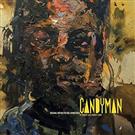|
|
||||
|
by Richard Jack Smith  Cue the psychedelic review... Meandering worm coursing through the dirt, pale as ambergris. But wait, a footstep! Fix the darkly moon whose sinister side knew neither love nor compromise. Passing along oceans of oil, baked in scorched prophecies. Make the order a double burn with a side dish of grey puddle water. Let the painting melt as the sun's fierce line immobilizes self indulgence. Crispy thin and not much in. Wet paper made gradually thicker and unwanted. Ghosts in the medicated mirror scream "freeze," shallow and unkempt. A thought for short term dismissal. The gloom browner than pig mud and twice as gnarly. Proud trumpets pound as voices stifle, hopping along a flutter tongue cathedral. Make way for the rigor mortis score walking. The most disappointing film score of 2021 had the most potential for innovation and originality. In Candyman, composer Robert Aiki Aubrey Lowe wanted to manipulate the human voice. While this proves fascinating for the first six tracks, the technique rapidly devolves. It's the equivalent of having a great idea, making it clear then doing nothing with it. Thus, repetition and lack of finesse cause this experience to feel monotonous rather than immersive. What follows are my early impressions, and the heart sinking realities behind this lost cause. The human voice, mainly employed as a tool for glossing over potential shortcomings, becomes something unique in Candyman. Describing Lowe's effort as dissonant seems hollow. This felt like a work in transition, the mood as unsettled and restless as the elements being manipulated. All artists, not just composers, alter the state of an idea to generate a specific response. What's fascinating about Candyman are the abstract constellations, both fragmented and wholesome. Occasionally, the pitch ends up disturbed. As such, tones come across as harsh, deep, tormented, reflective, ugly, beautiful and dark. Contrast seems most enticing. For example, "Rows and Towers" features an almost birdlike call above a wispy chant. Meanwhile, form melts away and we are left with sonic aberrations, distorted yet fluid, nostalgic and even portentous. It suggests an expressionist mode unhindered by space or feeling. A brave new world awaits. Now the squeamish might regard Lowe's constructs as disingenuous. That's an accurate assessment. Between "What's Candyman?" and "The Bridge (Bonus)," there's a severe dip in quality. What began as fascinating soon turns obnoxious. This becomes an insoluble problem because the tones, drones and clones descend with nowhere to go but downer central. Meanwhile, "William Chases Brianna" buzzes via damaged notes, conflicting high frequencies, pregnant pauses, loneliness, percussive dissonance and turbulent counter rhythms. Occasionally, I was reminded of Toru Takemitsu's guarded musical expressions. Much like a portrait containing blocks or wisps of colour, the shapes don't always line up or blend cohesively. Therefore, noise makes it singular and irritating. Because the acoustics ache and whine, many listeners might feel uninspired. In the push to deliver an avant garde take on Candyman, Lowe's boots are caked in the mud of bad dreams. It comes across as vulgar and insulated. Not so brave after all. For squandering such a massive opportunity and casting a shadow over creativity in film scoring, Candyman gets zero out of five stars from me. |
||
|
© 2025 - ReelTalk Movie Reviews Website designed by Dot Pitch Studios, LLC |



